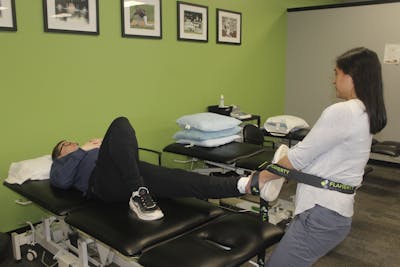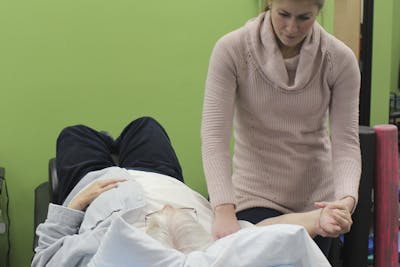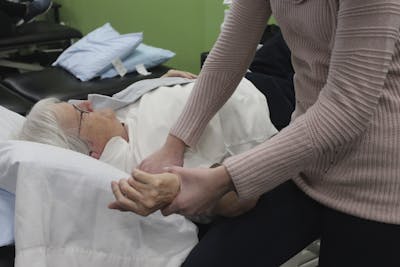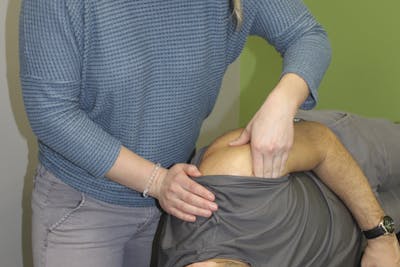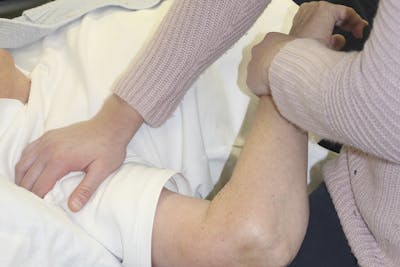-
Manual therapy is a hands-on treatment by clinicians to treat muscle aches, joint pain, and limited range of motion. It encompasses a variety of techniques including soft tissue mobilization of muscles, specific joint mobilization, and joint manipulation.
The three most notable forms of manual therapy are:
- Manipulation is the application of a rapid force into a joint(s). Manipulation is often associated with an audible popping sound called cavitation.
- Mobilization is a slower, more controlled process of articular and soft-tissue stretching intended to improve joint mobility.
- Massage is typically the repetitive rubbing, stripping or kneading of muscle and fascia tissues to facilitate healing.
Manual therapy has been proven to be an important part of an overall conservative treatment plan for a variety of conditions including:
- Adhesive capsulitis
- Shoulder impingement
- Shoulder stiffness/limited range of motion
- Tennis elbow
- Golfers elbow
- Pinched nerves
- Limited joint range of motion
- Capsule tightness
- Postsurgical stiffness
- Much more
For our current patients, we will make sure that your treating physical therapist discusses your PT case with our FDN therapists. Once a plan is in place, our fees are:
Single treatment:$95 (30 min.)3 treatments:$249 (30 min. @ $83/ea.)6 treatments:$480 (30 min.@ $80/ea.)Manual therapy is typically part of a complete treatment plan that is customized for your specific needs. Give us a call to learn how we can incorporate manual therapy into your rehabilitation program.
Call Us Today For More Information.
You Can Reach Us At(508) 393-9000 -
Massage is often used as part of a physical therapy treatment plan for soft tissue mobilization in order to reduce pain and inflammation as well as improve range of motion. There are several different types of massages that are used including instrument-assisted massage. Instrument assisted massage, also known as myofascial massage or instrument-assisted soft tissue mobilization (IASTM), is a modern manual therapy technique used to treat individuals diagnosed with soft tissue abnormalities. IASTM is performed with ergonomically designed instruments that detect and treat fascial (connective tissue) restrictions to effectively treat areas with soft tissue fibrosis (the formation of excess fibrous connective tissue in an organ or tissue in a reparative or reactive process to injury or damage - excessive scar tissue), chronic inflammation or degeneration. Using ergonomically designed hand-held instruments, IASTM clinicians comb over the skin to find soft tissue problems. Then, the instruments are used with the appropriate amount of pressure to introduce controlled microtrauma to the area. Controlled microtrauma initiates reabsorption of fibrosis (excessive scar tissue) and facilitates healing as adhesions in the soft tissue are broken down and absorbed by the body, allowing restoration of full function. There are several IASTM methods used by clinicians today, including Graston Technique, HawkGrips, Sound Assisted Soft Tissue Mobilization (SASTM) and Fluid Motion Soft Tissue Tools (FMST). Graston Technique, HawkGrips, and FMST Tools use steel or plastic instruments that glide along the muscle, tendon or ligament. The application of a specified amount of pressure allows the clinician to discover the location of the scar tissue or restrictions. The instruments are then used to break up the restriction to help the patient recover range of motion and functionality. SASTM works in a similar manner, except that the instruments locate restrictions through sound waves. Then, the tissue is treated with the appropriate amount of applied pressure. Some people have reported noticeable improvements after only one treatment. But most need 8-10 treatments over the course of a few weeks. No medications are required.
What to Expect
Prior to IASTM treatment, patients may be advised to complete five minutes of cardiovascular activity, such as riding a stationary bike or walking on a treadmill. Then, ultrasound or heat treatment may be applied to the injured area to warm up the soft tissue. During the treatment, the clinician will use the hand-held instruments to scan, then treat the affected area using very specific, calculated massage techniques over the affected area(s). Treatment usually lasts 30 to 60 seconds over each area treated. Some discomfort may be felt during treatment, and there may be some bruising and small red dots over the area that was treated (called petechiae). If this happens, ice application to the affected area for about 15 to 20 minutes following treatment will probably ease the discomfort. IASTM is generally done in conjunction with an exercise, stretching and strengthening program for rehabilitation to help the injured tissues heal and stay flexible as they heal.Conditions Treated
IASTM is an effective treatment option for a variety of conditions including:- Medial Epicondylitis (golfer's elbow)
- Lateral Epicondylitis (tennis elbow)
- Carpal Tunnel Syndrome
- Neck Pain
- Plantar Fascitis (foot pain)
- Rotator Cuff Tendinitis (shoulder pain)
- Patellar Tendinitis (knee pain)
- Tibialis Posterior Tendinitis
- Ankle Pain / Foot Pain / Heel Pain / Achilles Tendinitis
- DeQuervain's Syndrome
- Post-Surgical and Traumatic Scars
- Myofascial Pain and Restrictions
- Musculoskeletal Imbalances
- Chronic Joint Swelling Associated with Sprains/Strains
- Ligament Sprains
- Muscle Strains
- Non-Acute Bursitis
- Complex Regional Pain Syndrome (CRPS) / Reflex Sympathetic Dystrophy (RSD)
- Back Pain
- Trigger Finger
- Hip Pain (Replacements)
- IT Band Syndrome
- Shin Splints
- Chronic Ankle Sprains
- Acute Ankle Sprains (Advanced Technique)
- Surgical or Traumatic Scars
Call Us Today For More Information. You Can Reach Us At(508) 393-9000
-
Call For An Appointment
Call For An Appointment
Thanks for your interest in choosing Flaherty Physical Therapy as your trusted physical therapy provider.
Our goal is to give every patient a 5 star experience.
We recommend you call our office at 508-393-9000 and speak with one of our office staff who will make every effort to get you in as soon as possible for your initial evaluation.
When you call, please have the following items:
- Information about your insurance (medical, workers compensation or auto accident).
- Information on your physicians (both referring and primary care).
Thanks!
Kevin Flaherty, PT, CSCS Physical Therapist, Owner and Chief Mojo Officer
-
Pay Online



